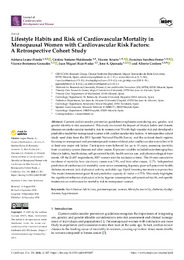Please use this identifier to cite or link to this item:
https://hdl.handle.net/11000/37672Full metadata record
| DC Field | Value | Language |
|---|---|---|
| dc.contributor.author | López Pineda, Adriana | - |
| dc.contributor.author | Soriano Maldonado, Cristina | - |
| dc.contributor.author | Arrarte, Vicente | - |
| dc.contributor.author | Sánchez Ferrer, Francisco | - |
| dc.contributor.author | Bertomeu-Gonzalez, Vicente | - |
| dc.contributor.author | Ruiz Nodar, Juan Miguel | - |
| dc.contributor.author | Quesada Rico, Jose Antonio | - |
| dc.contributor.author | Cordero, Alberto | - |
| dc.contributor.other | Departamentos de la UMH::Medicina Clínica | es_ES |
| dc.contributor.other | Departamentos de la UMH::Farmacología, Pediatría y Química Orgánica | es_ES |
| dc.date.accessioned | 2025-10-16T08:13:55Z | - |
| dc.date.available | 2025-10-16T08:13:55Z | - |
| dc.date.created | 2024-09-16 | - |
| dc.identifier.citation | J Cardiovasc Dev Dis . 2024 Sep 16;11(9):287 | es_ES |
| dc.identifier.issn | 2308-3425 | - |
| dc.identifier.uri | https://hdl.handle.net/11000/37672 | - |
| dc.description.abstract | Current cardiovascular prevention guidelines emphasise considering sex, gender, and gender identity in risk assessment. This study evaluated the impact of lifestyle habits and chronic diseases on cardiovascular mortality risk in women over 50 with high vascular risk and developed a predictive model for menopausal women with cardiovascular risk factors. A retrospective cohort study used data from the 2011 Spanish National Health Survey and the national death register, focusing on menopausal and postmenopausal women without prior cardiovascular events but with at least one major risk factor. Participants were followed for up to 10 years, assessing mortality from circulatory system diseases and other causes. Exposure variables included socio-demographics, lifestyle habits, health status, self-perceived health, health service use, and pharmacological treatments. Of the 21,007 respondents, 3057 women met the inclusion criteria. The 10-year cumulative incidence of mortality from circulatory causes was 5.9%, and from other causes, 12.7%. Independent predictors of cardiovascular mortality were never consuming legumes, poor self-perceived health, diabetes treatment, lack of physical activity, and older age. Lipid-lowering treatment was protective. The model demonstrated good fit and predictive capacity (C-index = 0.773). This study highlights the significant influence of physical activity, legume consumption, self-perceived health, and specific treatments on cardiovascular mortality risk in menopausal women. | es_ES |
| dc.format | application/pdf | es_ES |
| dc.format.extent | 11 | es_ES |
| dc.language.iso | eng | es_ES |
| dc.publisher | MDPI | es_ES |
| dc.rights | info:eu-repo/semantics/openAccess | es_ES |
| dc.rights | Attribution-NonCommercial-NoDerivatives 4.0 Internacional | * |
| dc.rights.uri | http://creativecommons.org/licenses/by-nc-nd/4.0/ | * |
| dc.subject | diabetes | es_ES |
| dc.subject | dyslipidaemia | es_ES |
| dc.subject | heart disease risk factors | es_ES |
| dc.subject | hypertension | es_ES |
| dc.title | Lifestyle Habits and Risk of Cardiovascular Mortality in Menopausal Women with Cardiovascular Risk Factors: A Retrospective Cohort Study | es_ES |
| dc.type | info:eu-repo/semantics/article | es_ES |
| dc.relation.publisherversion | 10.3390/jcdd11090287 | es_ES |

View/Open:
Lifestyle Habits and Risk of Cardiovascular Mortality in.pdf
565,33 kB
Adobe PDF
Share:
.png)
